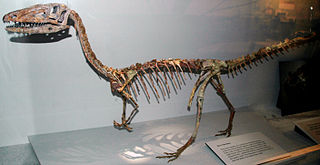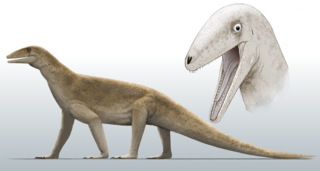
Coelophysis is a genus of coelophysid theropod dinosaur that lived approximately 215 to 208.5 million years ago during the Late Triassic period from the middle to late Norian age in what is now the southwestern United States. Megapnosaurus was once considered to be a species within this genus, but this interpretation has been challenged since 2017 and the genus Megapnosaurus is now considered valid.

Revueltosaurus is an extinct genus of suchian pseudosuchian from Late Triassic deposits of New Mexico, Arizona and North Carolina, United States. Many specimens, mostly teeth, have been assigned to Revueltosaurus over the years. Currently, three species are included in this genus, all of which were originally thought to represent monospecific genera of basal ornithischian dinosaurs. Revueltosaurus was about 1 meter long.
Krzyzanowskisaurus is the name given to a genus of archosaur from the Late Triassic-aged Chinle Formation and it is a tooth taxon, based on fossils only of teeth and these teeth have been found in the U.S. states of Arizona and New Mexico. The original report described it as a "probable ornithischian" and Heckert (2005) suggests that Krzyzanowskisaurus teeth have biostratigraphic utility as an index fossil of the St. Johnsian sub-LVF.
Protecovasaurus is a genus of archosaurian reptile from the Late Triassic of the southwestern United States. It was initially described as a basal ornithischian dinosaur, but was redescribed as a non-dinosaurian archosaur by Irmis et al. (2006). The type species, Protecovasaurus lucasi, was formally described by Andrew B. Heckert in 2004.

Nicrosaurus (/nɪkroʊˈsɔrəs/) is an extinct genus of phytosaur reptile existing during the Late Triassic period. Although it looked like a crocodile, it was not closely related to these creatures, instead being an example of parallel evolution. The main difference between Nicrosaurus and modern crocodiles is the position of the nostrils – Nicrosaurus's nostrils, or external nares, were placed directly in front of the forehead, whereas in crocodiles, the nostrils are positioned on the end of the snout. A 2013 study has also found that ilium of Nicrosaurus is quite distinctive from all other phytosaurs.

Doswellia is an extinct genus of archosauriform from the Late Triassic of North America. It is the most notable member of the family Doswelliidae, related to the proterochampsids. Doswellia was a low and heavily built carnivore which lived during the Carnian stage of the Late Triassic. It possesses many unusual features including a wide, flattened head with narrow jaws and a box-like rib cage surrounded by many rows of bony plates. The type species Doswellia kaltenbachi was named in 1980 from fossils found within the Vinita member of the Doswell Formation in Virginia. The formation, which is found in the Taylorsville Basin, is part of the larger Newark Supergroup. Doswellia is named after Doswell, the town from which much of the taxon's remains have been found. A second species, D. sixmilensis, was described in 2012 from the Bluewater Creek Formation of the Chinle Group in New Mexico; however, this species was subsequently transferred to a separate doswelliid genus, Rugarhynchos. Bonafide Doswellia kaltenbachi fossils are also known from the Chinle Formation of Arizona.

Trilophosaurus is a lizard-like trilophosaurid allokotosaur known from the Late Triassic of North America. It was a herbivore up to 2.5 m long. It had a short, unusually heavily built skull, equipped with massive, broad flattened cheek teeth with sharp shearing surfaces for cutting up tough plant material. Teeth are absent from the premaxilla and front of the lower jaw, which in life were probably equipped with a horny beak.
Redondasaurus is an extinct genus or subgenus of phytosaur from the Late Triassic of the southwestern United States. It was named by Hunt & Lucas in 1993, and contains two species, R. gregorii and R. bermani. It is the youngest and most evolutionarily-advanced of the phytosaurs.
Uatchitodon is an extinct genus of Late Triassic reptile known only from isolated teeth. Based on the structure of the teeth, Uatchitodon was probably a carnivorous archosauromorph. Folded grooves on the teeth indicate that the animal was likely venomous, with the grooves being channels for salivary venom. The teeth are similar to those of living venomous squamates such as Heloderma and venomous snakes. Uatchitodon is the earliest known venomous reptile.
Variodens is an extinct genus of trilophosaur. Fossils have been found from the Emborough Quarries in the Mendip Hills of Somerset, England. These fossils have been uncovered from a Late Triassic fissure fill within Carboniferous-age limestone. The type and only known species is V. inopinatus, named in 1957.

Daemonosaurus is an extinct genus of possible theropod dinosaur from the Late Triassic of New Mexico. The only known fossil is a skull and neck fragments from deposits of the latest Triassic Chinle Formation at Ghost Ranch. Daemonosaurus was an unusual dinosaur with a short skull and large, fang-like teeth. It lived alongside early neotheropods such as Coelophysis, which would have been among the most common dinosaurs by the end of the Triassic. However, Daemonosaurus retains several plesiomorphic ("primitive") traits of the snout, and it likely lies outside the clade Neotheropoda. It may be considered a late-surviving basal theropod or non-theropod basal saurischian, possibly allied to other early predatory dinosaurs such as herrerasaurids or Tawa.

Diodorus is a genus of silesaurid dinosauromorph that lived during the Late Triassic in what is now Morocco. Fossils were discovered in the Timezgadiouine Formation of the Argana Basin, and were used to name the new genus and species Diodorus scytobrachion. The genus name honors the mythological king Diodorus and the ancient historian Diodorus Siculus; the specific name is ancient Greek for 'leathery arm' and also honors the mythographer Dionysius Scytobrachion. The holotype specimen is a partial dentary bone (front of the lower jaw), and assigned specimens include isolated teeth, two humeri (upper arm bones), a metatarsal (foot bone), and femur (thigh bone).
The Colorado City Formation is a Late Triassic geologic formation in the Dockum Group of Texas, United States. It has previously been known as the Iatan Member, Colorado City Member or 'Pre-Tecovas Horizon'.

Azendohsauridae is a family of allokotosaurian archosauromorphs that lived during the Middle to Late Triassic period, around 242-216 million years ago. The family was originally named solely for the eponymous Azendohsaurus, marking out its distinctiveness from other allokotosaurs, but as of 2022 the family now includes four other genera: the basal genus Pamelaria, the large horned herbivore Shringasaurus, and two carnivorous genera grouped into the subfamily-level subclade Malerisaurinae, Malerisaurus and Puercosuchus, and potentially also the dubious genus Otischalkia. Most fossils of azendohsaurids have a Gondwanan distribution, with multiple species known across Morocco and Madagascar in Africa as well as India, although fossils of malerisaurine azendohsaurids have also been found in the southwestern United States of North America.

Robert Joseph Gay is an American Paleontologist known for his work in the Chinle and Kayenta Formations in the southwest United States. He is known for the discovery of the first occurrence of Crosbysaurus from Utah, as well as his studies of cannibalism in Coelophysis and sexual dimorphism in Dilophosaurus. Since 2014, Gay has taken high school students to the Chinle of Comb Ridge, Utah, and he is currently making new discoveries there. In December 2017, he and coauthors Xavier A. Jenkins of Arizona State University and John R. Foster of the Museum of Moab formally published their study on the oldest known dinosaur from Utah, a neotheropod that is likely an animal similar to Coelophysis. Robert Gay is currently the Education Director at the Colorado Canyons Association.

Kwanasaurus is an extinct genus of silesaurid dinosauromorph reptiles from the Late Triassic of Colorado. It is known from a single species, Kwanasaurus williamparkeri. Kwanasaurus had a deeper, stronger skull and greater specialization for herbivory compared to other silesaurids. It also possessed many unique characteristics of the snout, ilium, and lower part of the femur. It was described along with new specimens of Dromomeron from the Eagle Basin, the northernmost extent of the Chinle Formation.
Kraterokheirodon is an extinct genus of enigmatic tetrapod, that was possibly an amniote, from the Late Triassic Chinle Formation of Arizona. The type and only species is K. colberti. Although it is known only from two large teeth, their shape is so unlike those of any other animal that Kraterokheirodon cannot definitively be classified under any known group of tetrapods. Its discovery also indicates that our understanding of Late Triassic tetrapod diversity is still incomplete, with Kraterokheirodon representing an otherwise unknown lineage of large tetrapod in western North America.

Rugarhynchos is an extinct genus of doswelliid archosauriform from the Late Triassic of New Mexico. The only known species is Rugarhynchos sixmilensis. It was originally described as a species of Doswellia in 2012, before receiving its own genus in 2020. Rugarhynchos was a close relative of Doswellia and shared several features with it, such as the absence of an infratemporal fenestra and heavily textured skull bones. However, it could also be distinguished by many unique characteristics, such as a thick diagonal ridge on the side of the snout, blunt spikes on its osteoderms, and a complex suture between the quadratojugal, squamosal, and jugal. Non-metric multidimensional scaling and tooth morphology suggest that Rugarhynchos had a general skull anatomy convergent with some crocodyliforms, spinosaurids, and phytosaurs. However, its snout was somewhat less elongated than those other reptiles.
Syntomiprosopus is an extinct genus of archosauriform, possibly a crocodylomorph from the Late Triassic period of Arizona. The type and only known species is S. sucherorum. Syntomiprosopus was unusually short-snouted, comparable to the Late Cretaceous notosuchian Simosuchus, and is regarded as an example of convergent evolution between Triassic stem-archosaurs and Cretaceous archosaurs.

Puercosuchus is an extinct genus of archosauromorph reptile from the Late Triassic (Norian) of what is now Arizona, North America. It includes only the type species P. traverorum, and was described and named in 2022. Puercosuchus is known mainly from two bonebeds in the Blue Mesa Member of the Chinle Formation, preserving the mixed remains of multiple individuals in each one representing almost the entire skeleton. It is a member of the Azendohsauridae, a clade of Triassic reptiles that was initially recognised by adaptations for herbivory. However, Puercosuchus and its close relatives in the subclade Malerisaurinae retained the carnivorous diet and body form ancestral to archosauromorphs. Unlike non-malerisaurine azendohsaurids, Puercosuchus had a long and shallow snout with sharp, blade-like teeth similar to those of carnivorous dinosaurs. Despite its seemingly ancestral morphology and ecology, Puercosuchus is the youngest known genus of azendohsaurid in the world. The discovery of Puercosuchus allowed palaeontologists to recognise similar bones and teeth that had been collected from Late Triassic southwestern North America in the past as belonging to it or similar animals, acting as a sort of "rosetta stone" for malerisaurine azendohsaurid anatomy.
















